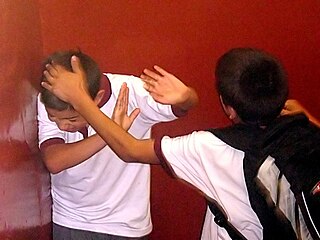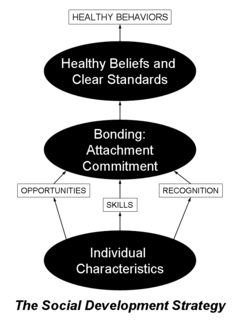Related Research Articles

Juvenile delinquency, also known as "juvenile offending", is the act of participating in unlawful behavior as a minor or individual younger than the statutory age of majority. For example, in the United States of America a juvenile delinquent is a person who is typically below 18 years of age and commits an act that otherwise would have been charged as a crime if they were an adult. Juvenile crimes can range from status offenses, to property crimes and violent crimes.

Physical abuse is any intentional act causing injury or trauma to another person or animal by way of bodily contact. In most cases, children are the victims of physical abuse, but adults can also be victims, as in cases of domestic violence or workplace aggression. Alternative terms sometimes used include physical assault or physical violence, and may also include sexual abuse. Physical abuse may involve more than one abuser, and more than one victim.

Youth empowerment is a process where children and young people are encouraged to take charge of their lives. They do this by addressing their situation and then take action in order to improve their access to resources and transform their consciousness through their beliefs, values, and attitudes. Youth empowerment aims to improve quality of life. Youth empowerment is achieved through participation in youth empowerment programs. However scholars argue that children's rights implementation should go beyond learning about formal rights and procedures to give birth to a concrete experience of rights. There are numerous models that youth empowerment programs use that help youth achieve empowerment. A variety of youth empowerment initiatives are underway around the world. These programs can be through non-profit organizations, government organizations, schools or private organizations.

Suicide prevention is a collection of efforts to reduce the risk of suicide. These efforts may occur at the individual, relationship, community, and society level. Suicide is often preventable.

The American juvenile justice system is the primary system used to handle minors who are convicted of criminal offenses. The system is composed of a federal and many separate state, territorial, and local jurisdictions, with states and the federal government sharing sovereign police power under the common authority of the United States Constitution. The juvenile justice system intervenes in delinquent behavior through police, court, and correctional involvement, with the goal of rehabilitation. Youth and their guardians can face a variety of consequences including probation, community service, youth court, youth incarceration and alternative schooling. The juvenile justice system, similar to the adult system, operates from a belief that intervening early in delinquent behavior will deter adolescents from engaging in criminal behavior as adults.
Crime prevention is the attempt to reduce and determine crime and criminals. It is applied specifically to efforts made by governments to reduce crime, enforce the law, and maintain criminal justice.
The Idaho Department of Juvenile Corrections (IDJC) is a state agency of Idaho that operates three juvenile correction centers and works closely with county probation departments to provide accountability, community protection, and rehabilitation to justice involved juveniles in Idaho. The three facilities are: Juvenile Corrections Center Lewiston (JCC-L), Juvenile Corrections Center Nampa (JCC-N), and Juvenile Corrections Center St. Anthony (JCC-SA). The agency has its headquarters in Boise.
Positive behavior support (PBS) is a form of applied behavior analysis that uses a behavior management system to understand what maintains an individual's challenging behavior and how to change it. People's inappropriate behaviors are difficult to change because they are functional; they serve a purpose for them. These behaviors are supported by reinforcement in the environment.
An at-risk student is a term used in the United States to describe a student who requires temporary or ongoing intervention in order to succeed academically. At risk students, sometimes referred to as at-risk youth or at-promise youth, are also adolescents who are less likely to transition successfully into adulthood and achieve economic self-sufficiency. Characteristics of at-risk students include emotional or behavioral problems, truancy, low academic performance, showing a lack of interest for academics, and expressing a disconnection from the school environment.

The health belief model (HBM)) is a social psychological health behavior change model developed to explain and predict health-related behaviors, particularly in regard to the uptake of health services. The HBM was developed in the 1950s by social psychologists at the U.S. Public Health Service and remains one of the best known and most widely used theories in health behavior research. The HBM suggests that people's beliefs about health problems, perceived benefits of action and barriers to action, and self-efficacy explain engagement in health-promoting behavior. A stimulus, or cue to action, must also be present in order to trigger the health-promoting behavior.

Communities That Care (CTC) is a program of the Center for Substance Abuse Prevention (CSAP) in the office of the United States Government's Substance Abuse and Mental Health Services Administration (SAMHSA). CTC is a coalition-based prevention operating system that uses a public health approach to prevent youth problem behaviors such as violence, delinquency, school drop out and substance abuse. Using strategic consultation, training, and research-based tools, CTC is designed to help community stakeholders and decision makers understand and apply information about risk and protective factors, and programs that are proven to make a difference in promoting healthy youth development, in order to most effectively address the specific issues facing their community's youth.
The Massachusetts Department of Youth Services (DYS) is a state agency of Massachusetts. Its Administrative Office is headquartered in 600 Washington Street Boston. The agency operates the state's juvenile justice services.
Multisystemic therapy (MST) is an intense, family-focused and community-based treatment program for juveniles with serious criminal offenses who are possibly abusing substances. It is also a therapy strategy to teach their families how to foster their success in recovery.
Peer victimization is the experience among children of being a target of the aggressive behavior of other children, who are not siblings and not necessarily age-mates.
Relapse prevention (RP) is a cognitive-behavioral approach to relapse with the goal of identifying and preventing high-risk situations such as unhealthy substance use, obsessive-compulsive behavior, sexual offending, obesity, and depression. It is an important component in the treatment process for alcohol use disorder, or alcohol dependence.
Children First, Offenders Second (CFOS) is a progressive and positive youth justice model that consists of eight principles. The model is structured to make a child the focus of any responses that are made, in view of their offending behavior.
School-based prevention programs are initiatives implemented into school settings that aim to increase children's academic success and reduce high-risk problem behaviors.
Positive criminology is based on the perspective that integration and positive life influences that help individuals develop personally and socially will lead to a reduced risk of criminal behavior and better recovery of offenders. Integration works in three levels: inter-personal, intra-personal and spiritual. Positive influences include participation in recovery programs, such as those for drug and alcohol abuse. Factors that can make growth difficult include a long-standing pattern of criminal activity, serious adverse life events, and chronic mental health illness.
Youth Intervention programs are community based services work with young people when they are first beginning to make poor decisions that can have lifelong negative repercussions. The goal of Youth Intervention programs is to encourage and build a young person's connections to the community, including developing meaningful relationships with caring adults, as a way to support academic achievement, as well as prevent juvenile delinquency.
Community Crime Prevention relates to interventions designed to bring reform to the social conditions that influence, and encourage, offending in residential communities. Community crime prevention has a main focus on both the social and local institutions found within communities which can influence crime rates, specifically juvenile delinquency.
References
- ↑ Haines, Kevin; Case, Stephen (2013-12-12). "Is the Scaled Approach a Failed Approach?". Youth Justice. 12 (3): 212–228. doi:10.1177/1473225412461212.
- ↑ Case, Stephen; Haines, Kevin (2015-05-01). "Children First, Offenders Second: The Centrality of Engagement in Positive Youth Justice". The Howard Journal of Criminal Justice. 54 (2): 157–175. doi:10.1111/hojo.12099. ISSN 1468-2311.
- ↑ Case, Stephen; Haines, Kevin (2014-12-14). "Children First, Offenders Second Positive Promotion: Reframing the Prevention Debate". Youth Justice. 15 (3): 226–239. doi:10.1177/1473225414563154.
- ↑ Kevin, Haines (2015). Positive youth justice : children first, offenders second. Case, Stephen. Bristol: Policy Press. ISBN 9781447321712. OCLC 912421305.